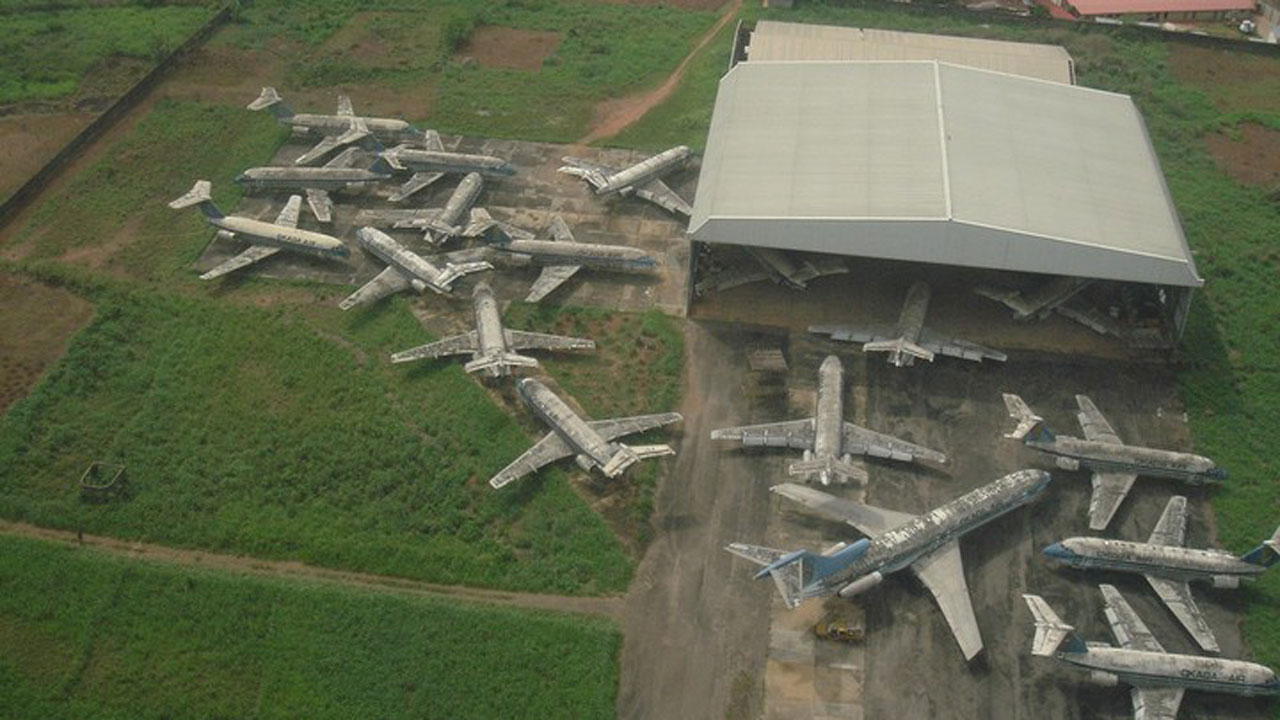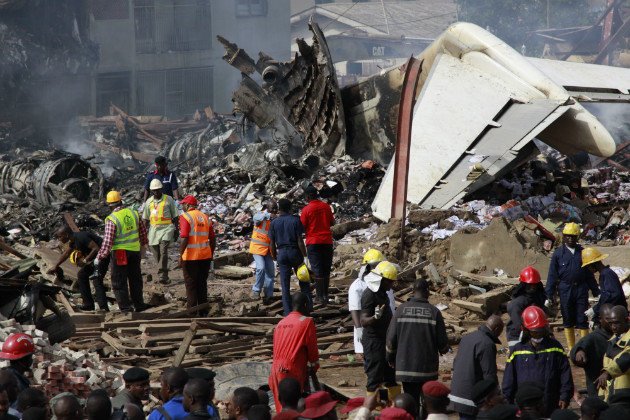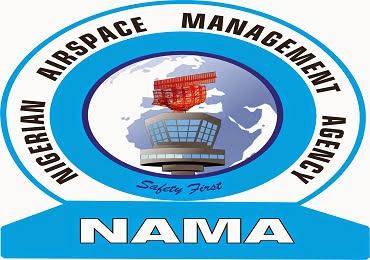How NCAA compromises safety, babysits incompetent airlines, covered up evidence of Dana crash


Tersoo Agber
With the benefit of hindsight, Nigeria’s air transport industry has been jinxed with safety and security lapses in the last five decades; from fatal accidents to rising incidences of runway mishaps, stowaways, and baggage hole hacking (or theft) at the nation’s airports, the industry is clearly left in the eye of the storm. Pundits say there is a problem with the regulatory oversight, not the airlines.
On accidents, cumulative reports from the Accident Investigation Bureau (AIB) indicate that about 3000 crash-related deaths have been recorded from 63 accidents within the period – 1969 –2013. Apart from major fatalities, few deaths have been recorded from stowaways and ground mishaps.
Although this record forms a fraction of 10,625 fatalities from 788 accidents recorded in the United States of America in the last 7 decades, making it the world’s worst record (data taken from the Aviation Safety Network), it puts Nigeria among the top 10 countries with worst fatalities in the world, and first in Africa with the highest risks.
NCAA condones incompetence – Dana case
What is worrisome is that there are no serious actions to mitigate the risks with a view to checking the causes of fatalities and addressing them headlong in line with the Standard and Recommended Practices on safety and security as enshrined in the Annexes of the International Civil Aviation Organisation (ICAO).
This is where the Nigerian Civil Aviation Authority (NCAA, which has the responsibility of oversight in the nation’s aviation industry, has been criticized for not living up to its statutory onus.
A former Captain and Commandant of the Murtala Muhammed International Airport, Lagos, Capt. John Ojikutu, told Business Eye that the agency has deliberately undermined safety regulations by aiding and abating incompetence and protecting airlines that should not be operating in the Nigeria airspace again.
He accused the regulator of covering up evidence of the cause of the Dana crash in 2012, thereby exposing the industry to perpetual danger against ICAO’s recommendations.
Referring to the 5th interim report of the AIB on the Dana Air crash that killed about 160 people in 2012, Ojikutu said the preceding reports earlier issued did not reveal the real cause of the accidents.
According to him, the NCAA manipulated the former leadership of AIB not to publish factual evidence of the cause of the Dana crash.
He said: “Before the release of the Final Report on the Dana accident on 13th March 2017, the AIB had released a Preliminary Report on 5th September 2012; Second Interim Statement on 3rd June 2014; Third and a Final Interim Statement on 3rd June 2015. However, after the Final Interim of 3rd June 2015, AIB still went and released a Fourth Interim Statement on 3rd June 2016.
“None of the Interim Statements and the Preliminary Report showed what many had known from the ATC communication transcripts as the direct cause of the accident. But for the new management, the AIB old management would have again probably released a 5th Interim Statement on 3rd June 2017,” said the Captain.
A few days after the crash, according to him, the Air Traffic Control communication transcripts that were released alongside the Preliminary Report had revealed even to the discerning public minds that the failure of the pilot to take necessary action following the flameout of one of the two aircraft engines 17 minutes after takeoff from Abuja was a direct cause of the crash.
“Unfortunately, the Preliminary Report and the subsequent Interim Statements did not contain this obvious evidence and fact to show that the pilot had violated essential regulation of the national civil aviation aircraft operating standards and the emergency management procedures in the Airline Operating Manual approved by the NCAA for such emergency situation,” he added.
The report, as released by the new management of AIB, revealed that the failure of the Dana pilot to take necessary actions in accordance with the Standard Emergency Procedures following the flameout of one of the aircraft engine 17 minutes after its takeoff from Abuja was an act of negligence and not an act exercised in error.
Ojikutu disclosed further that the pilot was not qualified but the NCAA fraudulently approved his license to work with Dana.
“Here was a captain who was employed by DANA on 14th March 2012. He had been earlier suspended in 2009 by the United State FAA for some misdemeanors on one of his flights which he did not record in the aircraft logbook nor reported as a negligent act.
“A revalidated license claimed to have been issued to him by NCAA though stamped but was not signed by any NCAA official fraudulent act. Most of the letters of recommendation submitted by the captain to his employer DANA and to NCAA were not signed; above all, the line training that preceded his captain checkout with Dana airlines had a lot of adverse remarks made by his training captain,” he said.
The Dana crash report issued in 2017 revealed that other crashes before it was never investigated thoroughly because of the manipulations of the NCAA, and lack of capacity at the AIB. Such crashes include the Bellview crash of October 2005; the Sossoliso crash of December 2005, among others.
Baggage theft is done by insiders
On baggage theft incidences involving Air Peace at the nation’s airports, the Captain also blamed NCAA for not learning from the past.
“Let’s take the issue of baggage hole theft or baggage hole hacking, for example. It has happened before in the 90s even when NCAA regulations were not able to regulate it, but we found a way to manage it. It is happening now. As a regulator, what should I look at? Since I know it has happened before, how was it managed? Was it within the management programme? Go back to what happened and check how it was managed. Then you now develop a management programme for it for various operators.
“If anything happens within your operating environment that is strange to your management programme, either safety or security, it is the responsibility of the regulator to go and check. Audit the entire process and team you have approved and check who is not there, or who is there that is not supposed to be there. Have we been able to do that? That is the problem.
“So what I expected was that the NCAA would first go to the airlines and ask “How many people are working with you?” That’s one. “How many people are working with you close to the aircraft?” that’s two. “How many have you sacked in the last few months?” “Did you collect your ID cards from them?” Did you collect the ODCs from them?” Somehow, something will tell you that there’s something missing and you will be able to trace it. It is an insiders’ problem, not from outside,” he said.
The Federal Airports Authority of Nigeria (FAAN) also has its share of the blame for issuing On Duty Cards indiscriminately without proper monitoring. What FAAN should be doing to curb such anomalies is by asking the airlines to account for all the ODCs given them. And when they fail to account for it, FAAN should hold them responsible. That is the standard in other sane climes.
This is necessary because it is capable of denting the image of the airlines and the airport officials, including the nation at large. But again, it is within the security programme approved by the NCAA, as domesticated in NCARs (Nigerian Civil Aviation Regulations), and issued to the airlines. So, the agency has the superior oversight mandate to question why such things happen and should take necessary measures to sanction culpable offenders.
The Captain also noted that the airlines need to check whether they have been paying salaries or not. If salaries are being owed, the guys may be hungry. “You laid off some staff but you have not paid them. They will find a way to get their money double.
“Something similar happened on Virgin Atlantic some years back. Some baggage was coming in and returning open. And everybody said let’s find out where and how it’s happening, and they discovered that it was not here but right from London where the staff was used on contract, and not paid regularly. It was when they stopped using them that the whole thing stopped.
“So these are issues they need to look inside. Nobody is coming from outside to steal in the aircraft. They can’t have that access,” he said.
Porous perimeter fences
No doubt, the aviation industry is one of the major contributors to global economic development by enabling faster and easier movement of passengers and goods for increased world trade activities.
Airports, especially international, have become the gateways or borderlines between countries. The importance and the prestige this has acquired are increasingly attracting criminals and terrorists who seek to pressure nations and promote selfish interests through the airports.
This calls for strict access control measures at the nation’s airports. Unfortunately, it has been compromised by the authority, Ojikutu observed. According to him, automation was the best option ever recommended to FAAN. “We’ve told them to automate this thing in such a way that if you are giving 20 ODC, you must be able to automate it. And you should be able to do regular audits to know how many you gave and how many left. And when there’s a deficiency, you will trace it.”
The perimeter fence is a big issue that has been there for a long time, and may not be solved “in the next 20 years,” said the Captain. “It will take the will of …I don’t want to say, God.”
“We have been on this issue way back in 2004. ICAO was here, I saw its report for 2004. It said our perimeter fence needs to be enhanced with a security fence. The perimeter fence is Annex 14 while the security fence is Annex 17.
“You want to use your perimeter fence as your security fence, you must enhance it to meet the provision of Annex 17. Alternatively, according to ICAO, make a secondary fence in place of the security fence. I think the alternative is the only thing we can do here. And as long as we have not done that, the airports will remain porous because no matter how many burglaries you put on the perimeter fence, it will not meet Annex 17. I would rather say the money they want to spend on CCTV should be used to build a second fence.
The captain disclosed further that in 2009, something happened at the airport and $6 billion was paid from NCAA’s account. Somebody somewhere made a mistake by putting an aircraft on a runway that was closed at the Murtala Muhammed Airport, Lagos, and $6 billion was paid from the NCAA account to the airline that crashed its aircraft on the runway that was closed. “So if anything happens in this airport, the airline affected will sue, the insurance will sue for compensation,” he said.
Concession of the airports, feasible or not?
The Federal Government is pursuing a PPP to improve airport infrastructure but must be careful not to privatize the aeronautical side of the airports. This is because “we have not developed ourselves to that level,” reasoned the Captain.
He suggested that what government can do is privatize the none-aeronautical side of the airports, which are the terminal buildings, cargo buildings, car parks, and toll gates. But it should be careful with the aeronautical side of the airports. This means FAAN has to map out the areas it wants to privatize.
“As we are talking about the perimeter fences, that’s the responsibility of the government because it’s an aspect of security. Don’t leave it to private hands because they will still need security. And the kind of security they would need is beyond their capability, not even now that we are talking of terrorists around.
“Secondly, 12 out of all these airports are joint-user responsibility. So you can only privatize the aspects that are already in private hands. Those already mentioned. The other aspect that will go side by side with it is the runway because the military needs it. They don’t need the terminal buildings and other areas. They need a perimeter fence because they would always want to know who jumps in or gatecrashes into the airport premises.
FAAN is stealing money…it’s handicapped
Much has been said of debt burdens between agencies and airlines, but in actual sense, the NCAA, FAAN, and NAMA are known to be protecting the domestic airlines, using them to steal money from the government.
Ojikutu disclosed to this magazine that the politicians are using the agencies to protect airlines. He said “Go to FAAN and NAMA, the two agencies, and find out how much each of these airlines owes. Two of the airlines I know owe about N541 billion, the Minister of State for Aviation, Hadi Sirika, said so recently. Perhaps Arik Air, which owes over N300 billion is one of them. But I don’t know the second one. All the airlines owe the agencies,” he said.
According to him, the only money that is keeping the agencies is the one foreign airlines are paying. But even that one is being stolen. “I have a document here that shows how money is being stolen in FAAN. If you ask them to account for what comes into their accounts, they won’t be able to do so. But we know all that is accruable to them based on their charges and those requiring their services. That’s why you see some foreign airlines going to almost all the airports in Nigeria because they are paying. And nobody is doing anything about it. All these things are supposed to be investigated by the NCAA.”







